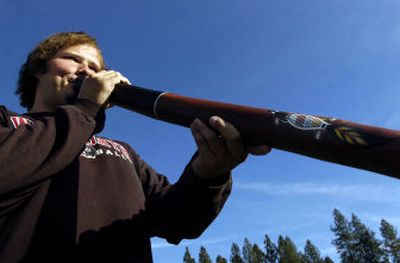He can do the didgeridoo

When Steve Honeyman was selected to compete in the “Mr. Kamiakin Contest” during his senior year in high school, he went in with a résumé that was absolutely loaded.
Honeyman was a straight-A student, valedictorian, four-year member of the choir and captain of the Kamiakin Braves football team.
But his mother, Debbie, still wonders if it wasn’t something else that ultimately swayed the judges in favor of her son – like his strange choice of instruments for the talent portion of the contest, perhaps.
“For his talent part, he played his didgeridoo,” she recalled. “I don’t know. That is kind of an unusual talent, so maybe that was what stood out with the judges.”
In any event, Honeyman won the contest. And five years later, as a senior and two-year starter on the offensive line of Whitworth College’s nationally ranked and unbeaten football team, he still regularly entertains friends by breaking out his didgeridoo and playing a few groaning notes.
“People think it’s funny, but I like it,” explained the 6-foot-2, 285-pounder from Kennewick. “It’s not a joke. It’s something that’s fun to do. It’s a hobby.
“Quite a few people have heard me play it, and it’s always interesting to give them a shot at trying to blow into it.”
Teammate Jon Erlenmeyer has heard several of Honeyman’s impromptu performances.
“He’s good,” Erlenmeyer said. “He knows what he’s doing.”
Still, Erlenmeyer admits there is something almost comical about watching someone of Honeyman’s vast proportions trying to coax sounds out of a bizarre-looking wind instrument similar to those that have been produced and played by the aboriginal people of northern Australia for thousands of years.
“The majority of people think it’s funny and cool at the same time,” he said. “And Steve can sustain a sound for a long, long time.”
Didgeridoos, also known as drone pipes, are cylindrical or conical in shape and usually made from hardwoods, such as eucalyptus, which are commonly found in northern Australia.
Honeyman, who played the violin in middle school and still dabbles with the bass guitar he also has with him at school, first became interested in learning to play the didgeridoo while attending a music festival with his parents during his junior year in high school.
“My dad is big into folk music,” Honeyman said of his father, James, who plays the mandolin in a bluegrass band. “We were at this music festival and this guy started playing one, and I started talking to him about it.”
Debbie Honeyman wasn’t surprised to see her musically gifted son take an interest in such an obscure instrument.
“He’s always been kind of curious about different things,” she said. “And it doesn’t necessarily have to be something that’s popular at the time to get him interested. In this case, it was a little unusual, but he was fascinated by it.
“And I thought it was kind of interesting to hear him play it.”
Before deciding to spring for a real didgeridoo, however, the Honeymans made sure their son was sincere in his desire to learn to play one.
“They had me practice using PCV pipe and those cardboard rolls that wrapping paper comes on,” Honeyman recalled.
But eventually his parents gave in and ordered a didgeridoo over the Internet, opting for one of medium quality rather than a top-of-the-line model – some of which, according to Honeyman, sell for upwards of $300.
“When I tell people I have one, a lot of them don’t know what it is,” Honeyman admitted. “I have to explain that it’s ‘that big, long Australian thing you have to blow into.’ “
Despite Erlenmeyer’s gushing assessment of his teammate’s work on the didgeridoo, Honeyman admits he is far from having the instrument mastered.
Some of the more notable didgeridoo players, he explained, employ a technique known as circular breathing that allows them to breathe in through the nose while simultaneously blowing air, through vibrating lips, into the instrument.
“People that are really good at it can continue to make the noise,” Honeyman said. “I haven’t quite got that down, yet, but I can do quite a few things with it.
“You can’t really play songs, though. It just makes kind of a background noise. But it’s relaxing for me, so if I get stressed out about school or football, I get it out and play it.”
Debbie Honeyman remains content with her son’s choice of instruments, realizing he could have opted for a drum set. And she admits she sometimes misses the soothing drone of the didgeridoo around the house.
“It’s a very low sound, and you can’t really make it too loud,” she said. “It’s kind of an unusual sound, but it was never annoying.
“It could have been much worse.”